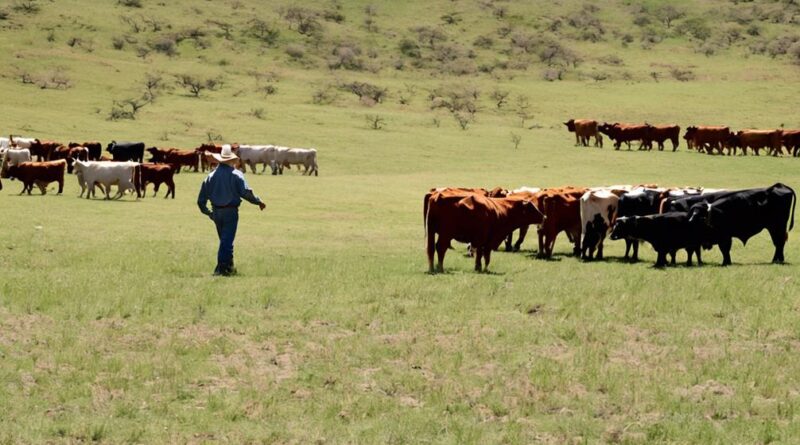Why Use Gentle Cattle Handling Techniques?
When it comes to managing your cattle, it's essential to consider the long-term benefits of employing gentle handling techniques.
The way you handle your cattle can have a significant impact on their well-being and productivity.
But why should you bother with gentle techniques, you ask?
Well, the answer goes beyond just the welfare of the animals; it also affects your bottom line in ways that might surprise you.
Curious to find out more about the compelling reasons behind this approach?
Stay tuned to discover how gentle cattle handling can make a difference in your operations.
Benefits of Gentle Handling
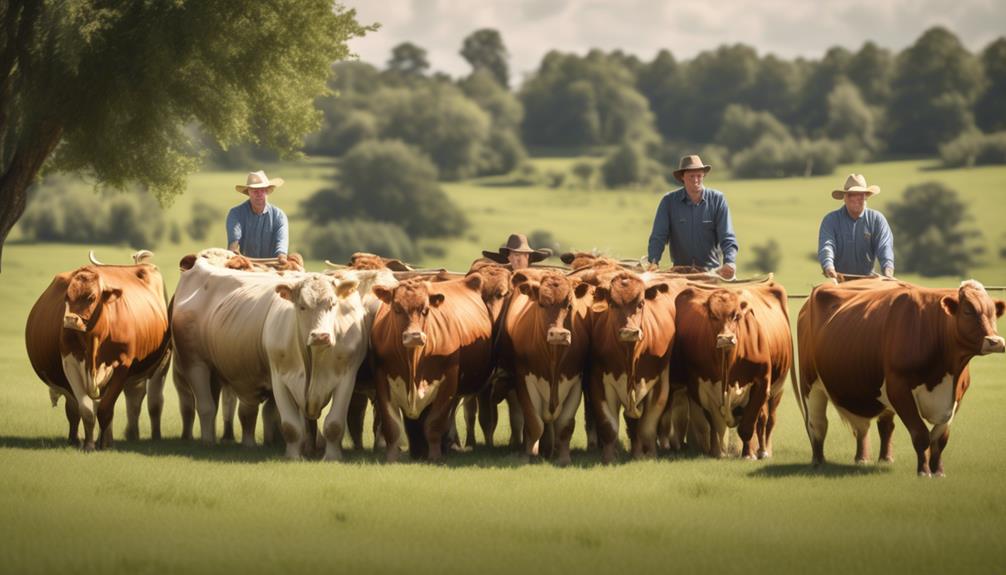
Gentle cattle handling techniques offer a range of benefits, including reduced stress and improved overall animal welfare. By utilizing these methods, you can effectively minimize the stress experienced by the cattle, leading to a calmer and more content herd. When stress is reduced, the animals are less likely to exhibit aggressive or agitated behavior, creating a safer environment for both the cattle and the handlers.
Furthermore, the benefits of gentle cattle handling extend beyond stress reduction. Research has shown that implementing these techniques can lead to improved weight gain and overall health in cattle. When the animals are less stressed, they're more likely to eat properly and maintain a healthy weight, ultimately contributing to better meat or milk production.
In addition to the physical benefits, gentle handling also has a positive impact on the animals' emotional well-being. Cattle that are handled with care and respect are more trusting and less fearful, resulting in a more harmonious relationship between the animals and their handlers. This can lead to easier and safer handling procedures, as well as a more positive experience for both the cattle and the individuals working with them.
Understanding Cattle Behavior
Understanding cattle behavior is crucial for effective livestock management and ensuring the well-being of the animals in your care. By comprehending cattle psychology and herd dynamics, you can create a low-stress environment and handle your cattle more effectively.
Here are three key aspects of understanding cattle behavior:
- Cattle Psychology: Cattle, like humans, experience fear, anxiety, and stress. Understanding their psychology can help you anticipate their reactions in different situations. For instance, sudden movements or loud noises can trigger a stress response in cattle, leading to agitated behavior. By being aware of this, you can modify your handling techniques to minimize stress and ensure a calmer demeanor in your herd.
- Herd Dynamics: Cattle are social animals that function within a herd dynamic. They've a hierarchical structure and use body language and vocalizations to communicate with each other. Recognizing the dynamics within the herd allows you to understand how individual cattle interact and react to various stimuli. This understanding enables you to work with their natural behavior rather than against it, promoting a more harmonious and cooperative atmosphere.
- Communication and Trust: Developing an understanding of cattle behavior fosters better communication and trust between you and your animals. By observing their body language and responses, you can adjust your approach to gain their trust and cooperation, ultimately leading to smoother handling and reduced stress for the cattle.
Creating Low-Stress Environments
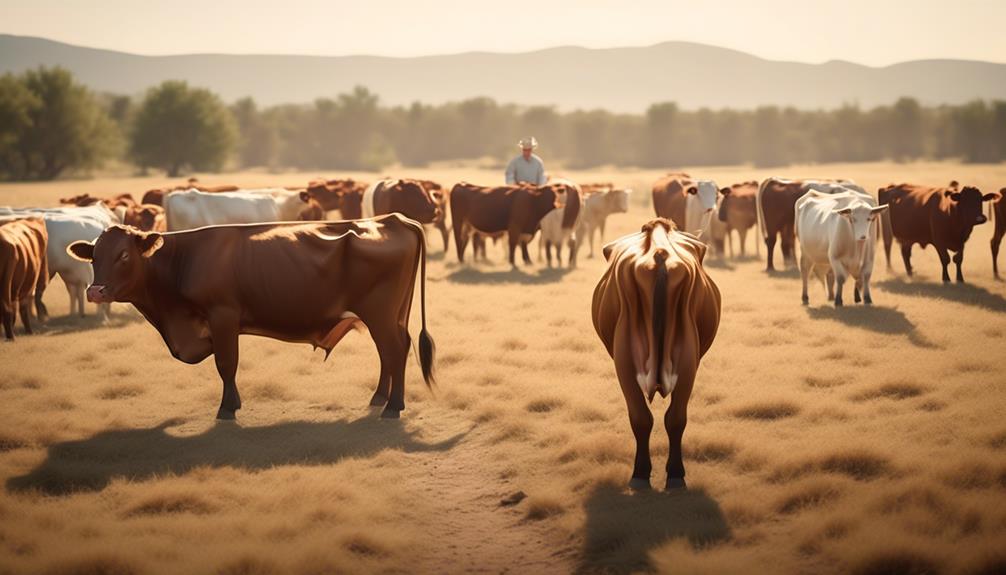
To create a low-stress environment for your cattle, prioritize providing a calm and predictable atmosphere in their living and handling spaces. Low-stress handling techniques are crucial for the well-being and productivity of your cattle. By minimizing fear and stress, you can positively impact their behavior and overall health.
One of the most effective ways to achieve this is through positive reinforcement. Positive reinforcement involves rewarding desired behaviors, such as moving calmly through handling facilities, with a pleasant stimulus, like access to food or a comfortable resting area. By consistently using positive reinforcement, you can create an environment where cattle associate handling processes with positive experiences, reducing their stress levels and increasing their cooperation.
Furthermore, maintaining a quiet and peaceful environment is essential. Loud noises, sudden movements, or chaotic handling procedures can trigger anxiety and fear in cattle. By contrast, a serene atmosphere with gentle movements and soft vocal cues can help keep stress levels low and promote a sense of security among the herd.
Additionally, ensuring that handling procedures are consistent and predictable can further contribute to a low-stress environment. Cattle thrive when they understand what's expected of them, so establishing clear routines and using gentle, non-threatening methods for handling can significantly reduce their stress levels.
Importance of Patience
Creating a low-stress environment for your cattle hinges on prioritizing a calm and predictable atmosphere in their living and handling spaces. One crucial aspect of achieving this is recognizing the importance of patience in your interactions with the animals. Patience plays a significant role in effective communication with cattle, and here's why:
- Building Trust: Patience allows you to build trust with your cattle. By giving them the time they need to process and respond to your cues, you establish a foundation of trust and understanding. This trust is essential for effective communication and cooperation between you and the animals.
- Reducing Stress: When handling cattle, impatience can lead to stress and anxiety in the animals. This can result in erratic behavior and an increased risk of injury. Patience, on the other hand, helps to keep stress levels low by allowing the animals to move at their own pace and feel secure in their environment.
- Enhancing Learning: Cattle, like any living beings, require time to learn and adapt to new situations. Patience in your interactions allows the animals to learn and understand your cues, making training and handling more effective in the long run.
Utilizing Proper Tools and Equipment
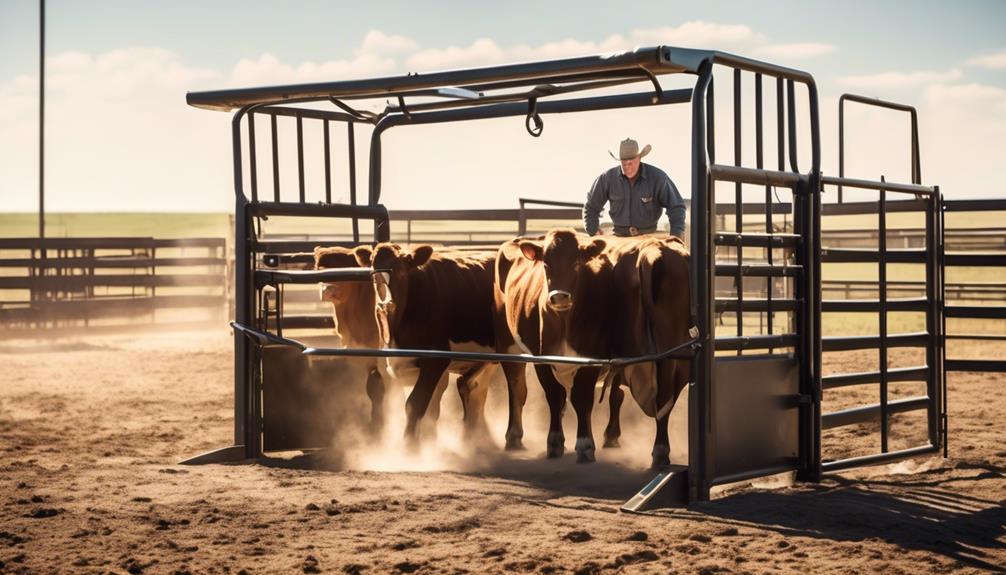
When handling cattle, it's essential to ensure that you have the proper tools and equipment to facilitate safe and effective interactions with the animals. Proper tools and effective equipment play a crucial role in ensuring the safety of both the cattle and the handlers.
One of the most important tools in cattle handling is a well-designed and sturdy chute. A chute is essential for safely restraining cattle during procedures such as vaccinations, hoof trimming, and pregnancy checks. It's important to ensure that the chute is in good working condition and properly maintained to prevent injuries to the cattle and the handlers.
Additionally, using tools such as cattle prods or electric goads should be approached with caution and used sparingly, as excessive use can cause stress and injury to the animals.
Another essential piece of equipment for safe cattle handling is a well-constructed and properly maintained corral system. A sturdy corral with smooth, rounded edges helps prevent injuries to the cattle as they're being moved through the system. In addition, having appropriate safety measures in place, such as non-slip flooring in handling areas and gates that can be easily opened and closed, contributes to a safer and more efficient handling process.
Utilizing proper tools and equipment not only ensures the safety and well-being of the cattle but also contributes to a more efficient and stress-free handling experience for both the animals and the handlers.
Training for Effective Communication
Ensuring that your cattle handling team communicates effectively with each other and with the animals is crucial for maintaining a safe and low-stress environment, which can be further enhanced by proper training. Effective communication is essential for understanding animal behavior and ensuring that the handling process is as calm and stress-free as possible. Here are some key aspects to focus on when training for effective communication:
- Body Language: Teach your team to be aware of their own body language and to understand how cattle may interpret it. For example, sudden movements or aggressive postures can agitate the animals, while calm and open body language can help to reassure them.
- Vocal Cues: Encourage your team to use consistent and gentle vocal cues when interacting with the cattle. Cows can become familiar with specific voices and tones, so using calming and reassuring voices can help to keep them relaxed.
- Team Coordination: Train your team to work together seamlessly, using clear and concise signals to communicate with each other. This includes understanding each other's movements and coordinating actions to ensure that the animals are handled in a coordinated and controlled manner.
Developing Trust and Respect
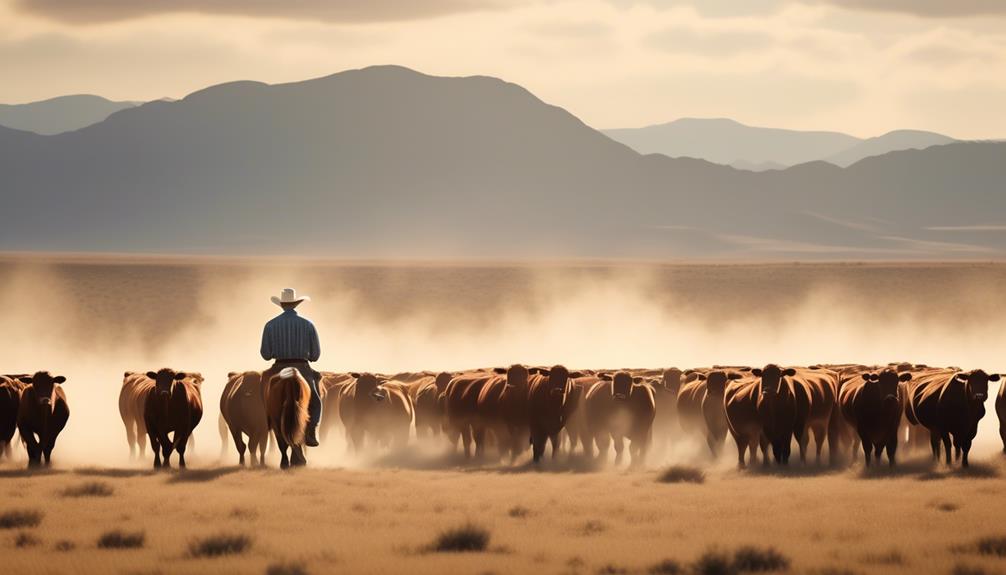
Encouraging gentle and consistent interactions with cattle is essential for developing trust and respect in handling practices. By approaching the animals calmly and using non-threatening body language, you can begin building rapport and earning trust.
When handling cattle, it's crucial to remember that they're sentient beings capable of forming relationships based on mutual respect. By consistently treating them with kindness and patience, you can establish a foundation of trust that will make handling them easier and less stressful for both parties.
One way to develop trust and respect in handling cattle is through regular, positive interactions. Spending time with the animals, observing their behavior, and understanding their individual personalities can help foster a sense of trust. By approaching them gently and consistently, you can show them that you're a reliable and non-threatening presence. This can lead to a more cooperative and less stressful handling experience for everyone involved.
It's important to remember that earning trust and respect from cattle is an ongoing process that requires patience and understanding. By consistently using gentle handling techniques and avoiding aggressive or forceful behaviors, you can continue to build trust and respect over time. This approach not only benefits the well-being of the animals but also contributes to a safer and more efficient handling environment for handlers and cattle alike.
Impact on Animal Welfare and Productivity
To enhance animal welfare and productivity, prioritize implementing gentle cattle handling techniques to create a positive and stress-free environment for the animals. By doing so, you can significantly impact animal behavior and stress levels, ultimately leading to improved overall well-being and increased productivity. Here's how gentle cattle handling techniques can positively influence animal welfare and productivity:
- Reduced Stress Levels: Gentle handling techniques help minimize stress in cattle. When animals experience less stress, they're less prone to health issues and behavioral problems. This can lead to improved weight gain, reproductive success, and overall herd performance.
- Enhanced Animal Behavior: Gentle handling promotes positive animal behavior. Cattle are more likely to exhibit natural and calm behavior when they feel safe and unthreatened. This can result in improved handling efficiency and reduced injuries for both the animals and handlers.
- Improved Productivity: A stress-free environment and positive animal behavior directly contribute to enhanced productivity. Calmer and healthier cattle are more efficient in converting feed to meat or milk, leading to better production outcomes.
Implementing gentle cattle handling techniques isn't only beneficial for the animals' well-being but also for the overall productivity of your operation. By prioritizing the reduction of stress and the promotion of positive behavior, you can create a more harmonious and efficient environment for both the cattle and your business.
Frequently Asked Questions
What Are Some Common Mistakes Made When Handling Cattle That Can Lead to Stress and Agitation?
When handling cattle, common mistakes can lead to stress and agitation, impacting their well-being. Improving your handling techniques, such as avoiding loud noises and sudden movements, can reduce stress and create a calmer environment for the cattle.
How Can Gentle Cattle Handling Techniques Impact the Overall Health and Well-Being of the Animals?
Gentle cattle handling techniques can impact productivity by reducing stress, improving overall health, and fostering trust. It's important to build trust with the animals to ensure their well-being and productivity.
Are There Specific Breeds or Types of Cattle That May Respond Better to Gentle Handling Techniques?
Certain breeds, like Holsteins and Angus, may exhibit varying handling responsiveness due to their individual characteristics. Understanding these traits can help you tailor gentle cattle handling techniques to suit their specific needs for better overall well-being.
Can Implementing Gentle Handling Techniques Also Improve the Quality of the Meat or Dairy Products Produced by the Cattle?
Implementing gentle handling techniques can improve the quality of meat or dairy products produced by the cattle. It reduces stress, resulting in better meat tenderness and improved milk production. Additionally, it enhances animal welfare benefits and overall productivity.
Are There Any Potential Drawbacks or Challenges to Using Gentle Cattle Handling Techniques, and How Can They Be Addressed?
When addressing challenges of implementing gentle cattle handling techniques, you can consider training methods and behavior modification. By understanding cattle behavior and using positive reinforcement, you can ensure effective and humane handling practices.
Conclusion
In conclusion, using gentle cattle handling techniques is essential for creating a low-stress environment, understanding cattle behavior, and ultimately improving animal welfare and productivity.
By utilizing proper tools, training for effective communication, and developing trust and respect, you can ensure the well-being of your cattle and enhance the overall productivity of your operation.
Embracing gentle handling techniques isn't only beneficial for the animals, but also for your bottom line.
